Margo can peel and slice at least 10 dozen apples per hour and at most 15 dozen apples per hour. Based on this information,what is the possible amount of time, in hours, that it could take Margo to peel and slice 60 dozen apples?
The correct Answer is:4lerle6
To solve the problem, we need to determine the possible amount of time, in hours, that Margo could take to peel and slice 60 dozen apples given her peeling rates.
1. Identify the rates: Margo can peel and slice at least 10 dozen apples per hour and at most 15 dozen apples per hour.
2. Set up the variable: Let h represent the time in hours that Margo takes to peel and slice 60 dozen apples.
3. Calculate time at minimum speed:
- If Margo works at her minimum speed of 10 dozen apples per hour, the time taken to peel 60 dozen apples can be calculated as:
h≥60 dozen10 dozen/hour=6 hours
This means that if she works at her slowest speed, she will take at least 6 hours.
4. Calculate time at maximum speed:
- If Margo works at her maximum speed of 15 dozen apples per hour, the time taken to peel 60 dozen apples can be calculated as:
h≤60 dozen15 dozen/hour=4 hours
This means that if she works at her fastest speed, she will take at most 4 hours.
5. Combine the inequalities:
- From the calculations, we have two inequalities:
- h≥4 (at maximum speed)
- h≤6 (at minimum speed)
- Combining these gives us:
4≤h≤6
6. Conclusion: The possible amount of time h that Margo could take to peel and slice 60 dozen apples is between 4 and 6 hours, inclusive.
Final Answer:
The possible amount of time that Margo could take is 4≤h≤6 hours.
---
- If Margo works at her minimum speed of 10 dozen apples per hour, the time taken to peel 60 dozen apples can be calculated as:
h≥60 dozen10 dozen/hour=6 hours
This means that if she works at her slowest speed, she will take at least 6 hours.
- If Margo works at her maximum speed of 15 dozen apples per hour, the time taken to peel 60 dozen apples can be calculated as:
h≤60 dozen15 dozen/hour=4 hours
This means that if she works at her fastest speed, she will take at most 4 hours.
- From the calculations, we have two inequalities:
- h≥4 (at maximum speed)
- h≤6 (at minimum speed)
- Combining these gives us:
4≤h≤6
The possible amount of time that Margo could take is 4≤h≤6 hours.
Topper's Solved these Questions
Similar Questions
Wyatt can husk at least 12 dozen ears of corn per hour and at most 18 dozen ears of corn per hour. Based on this information, what is a possible amount of time, in hours, that it could take Wyatt to husk 72 dozen ears of corn?
View SolutionA man buys 8 dozens of mangoes, 10 dozens of apples and 4 dozens of bananas. Mangoes cost Rs. 18 per dozen, apples Rs. 9 per dozen and bananas Rs 6 per dozen. Represent the quantities bought by a row matrix and the prices by a column matrix and hence obtain the total cost.
View Solution
Knowledge Check
Is It the Heart or the Brain? I saw you from across the room, and I knew immediately. My pulse began to race, I started to sweat, I could barely breathe. From the first moment that I laid eyes on you, I was convinced that you were the one. On our first date, the chemistry was obvious. We laughed and smiled and held hands and talked for hours. I couldn't sleep or eat or even pay attention at work. I just had to be with you. Within one-fifth of a second, your physical appearance and body language caused an excessive release of dopamine in my brain creating feelings of excitement and happiness. We made eye contact for 8.2 seconds, your pheromones were indistinguishable from my mother's. Then, your voice triggered my brain mechanism for generating long-term attachment, and, for the next several days, my neurotransmitters sent obsessive message after message, accompanying thoughts of you with feelings of euphoria. Once vasopressin and oxytocin reached my receptors, I knew that I could never be without you. Although the former description of "falling in love" is far more prevalent, it is the latter that has scientists speculating that love is more biological than cultural. Helen Fisher, American anthropologist and professor at Rutgers University, studies romantic interpersonal attraction and states that love begins with a focus on one person that results in obsessive thinking. In her essay, "The Realities of Love at First Sight," Fisher explains how we evaluate an individual within three minutes of meeting them based on their physical attributes, voice, and words. First, we decide if they are attractive, then we evaluate their clothing and stature, before moving on to the sound and tone of their voice. Lastly, we consider what they actually say. She concludes that we choose partners whose biological chemicals complement our own. Fisher's research has even gone further to explain the science behind falling in love. She theorizes that humans have three brain systems for loving: lust, which is associated with testosterone, attraction, which is linked to dopamine, and attachment, which is brought on by increased levels of oxytocin and vasopressin. While these three systems can surely overlap, they also exist separately from one another which, for Fisher, explains why loving more than one person at a time is quite possible. However, Fisher isn't convinced that love is entirely biological. The Economist describes the phenomenon like this: "a chemical state with genetic roots and environmental influences. Yet, the connection between love and brain chemicals is far too certain to ignore. Psychology Today renders love a three-step scientific process. First, a release of the hormone dopamine causes "feel good" emotions. In this stage, we feel attracted to an individual and associate them with feelings of intense joy. Next, our neurotransmitters-norepinephrine and phenylethylamine-lead to focused attention on the object of our attraction and feelings of giddiness that make it hard to sleep and decrease our appetite. Lastly, our brain reward system is activated, sending chemical messages to various parts of the body that elevate mood and make an addiction-like urge to be with that person. Biologically, that is the extent of love. Comparing love to a chemical addiction is actually a quite common metaphor, within poetry and music, but it also happens within the sciences. Deepak Chopra, physician and public speaker, postulates that love stems from an impulse and behaves within our brain very similarly to a drug addiction. Stephanie Ortigue is a professor at Syracuse University and describes the addiction-like qualities as a result of twelve different areas of the brain working in tandem to release euphoria-inducing chemicals such as adrenaline, dopamine, oxytocin, and vasopressin. Oxytocin, known as "the love hormone," is why we feel calm and cuddly with our significant others. When it comes to "love at first sight," biologists are asserting that it actually does happen-in about 11% of love encounters, the attachment mechanism within the brain can be triggered within the first few minutes of meeting someone. The Huffington Post contends that the optimal environment for love at first sight takes place in encounters with about 8 seconds of continuous eye contact, in cases where individuals stared into one another's eyes for 4.5 seconds or less, the chances for love were dismal. It would appear that new research has love down to a science.
based on the information in the graph, it is most likely that the sample of people researchers referred to in lines 50-52 ("when it... someone") was aAgroup of only menBgroup of only womenCgroup of both men and womenDgroup of scholars in the subjectHow Do You Like Those Apples? Marketed as SmartFresh, the chemical 1-MCP (1-methylcyclopropene) has been used by fruit growers since 2002 in the United States and elsewhere to preserve the crispness and lengthen the storage life of apples and other fruit, which often must travel long distances before being eaten by consumers. 23 1-MCP lengthens storage life by three to four times when applied to apples. This extended life allows producers to sell their apples in the off-season, months after the apples have been harvested. And at a cost of about one cent per pound of apples, 1-MCP is a highly cost-effective treatment. However, 1-MCP is not a panacea for fruit producers or sellers: there are problems and limitations associated with its use.[1] 1-MCP works by limiting a fruit’s production of ethylene, 24 it is a chemical that causes fruit to ripen and eventually rot. [2] While 1-MCP keeps apples 25 tight and crisp for months, it also limits 26 their scent production. [3] This may not be much of a problem with certain kinds of apples that are not naturally very fragrant, such as Granny Smith, but for apples that are prized for their fruity fragrance, such as McIntosh, this can be a problem with onsumers, 27 that will reject apples lacking the expected aroma. [4] But some fruits do not respond as well to 1-MCP as others 28 did, and some even respond adversely. [5] Furthermore, some fruits, particularly those that naturally produce a large amount of ethylene, do not respond as well to 1-MCP treatment. [6] Take Bartlett 29 pears, for instance, unless they are treated with exactly the right amount of 1-MCP at exactly the right time, they will remain hard and green until they rot, and consumers who experience this will be unlikely to purchase them again. 30 Finally, researchers have found that 1-MCP actually increases susceptibility to some pathologies in certain apple varieties. For example, Empire apples are prone to a condition that causes the flesh of the apple to turn brown. Traditionally, apple producers have dealt with this problem by leaving the apples in the open air for three weeks before storing them in a controlled atmosphere with tightly regulated temperature, humidity, and carbon dioxide levels. As the graph shows, the flesh of untreated Empire apples that are first stored in the open air undergoes 31 roughly five percent less browning than the flesh of untreated Empire apples that are immediately put into storage in a controlled environment. However, when Empire apples are treated with 1-MCP, 32 their flesh turns brown when the apples are first stored in the open air, though not under other conditions. Although researchers continue to search for the right combination of factors that will keep fruits fresh and attractive, 33 the problem may be that consumers are overly concerned with superficial qualities rather than the actual freshness of the fruit.
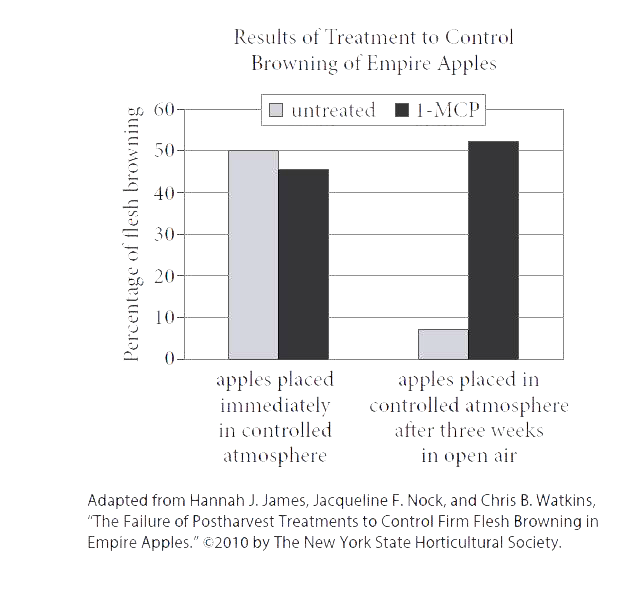
Which choice most effectively combines the underlined sentences?AWhen applied to apples, 1-MCP lengthens storage life by three to four times, allowing producers to sell their apples in the off-season, months after the apples have been harvested.BProducers are allowed to sell their apples months after they have been harvested—in the off-season—because 1-MCP, when applied to apples, lengthens their storage life by three to four timesC1-MCP lengthens storage life, when applied to apples, by three to four times, allowing producers to sell their apples months after the apples have been harvested in the off-season.DMonths after apples have been harvested, producers are allowed to sell their apples, in the off-season, because 1-MCP lengthens storage life when applied to apples by three to four times.How Do You Like Those Apples? Marketed as SmartFresh, the chemical 1-MCP (1-methylcyclopropene) has been used by fruit growers since 2002 in the United States and elsewhere to preserve the crispness and lengthen the storage life of apples and other fruit, which often must travel long distances before being eaten by consumers. 23 1-MCP lengthens storage life by three to four times when applied to apples. This extended life allows producers to sell their apples in the off-season, months after the apples have been harvested. And at a cost of about one cent per pound of apples, 1-MCP is a highly cost-effective treatment. However, 1-MCP is not a panacea for fruit producers or sellers: there are problems and limitations associated with its use.[1] 1-MCP works by limiting a fruit’s production of ethylene, 24 it is a chemical that causes fruit to ripen and eventually rot. [2] While 1-MCP keeps apples 25 tight and crisp for months, it also limits 26 their scent production. [3] This may not be much of a problem with certain kinds of apples that are not naturally very fragrant, such as Granny Smith, but for apples that are prized for their fruity fragrance, such as McIntosh, this can be a problem with consumers, 27 that will reject apples lacking the expected aroma. [4] But some fruits do not respond as well to 1-MCP as others 28 did, and some even respond adversely. [5] Furthermore, some fruits, particularly those that naturally produce a large amount of ethylene, do not respond as well to 1-MCP treatment. [6] Take Bartlett 29 pears, for instance, unless they are treated with exactly the right amount of 1-MCP at exactly the right time, they will remain hard and green until they rot, and consumers who experience this will be unlikely to purchase them again. 30 Finally, researchers have found that 1-MCP actually increases susceptibility to some pathologies in certain apple varieties. For example, Empire apples are prone to a condition that causes the flesh of the apple to turn brown. Traditionally, apple producers have dealt with this problem by leaving the apples in the open air for three weeks before storing them in a controlled atmosphere with tightly regulated temperature, humidity, and carbon dioxide levels. As the graph shows, the flesh of untreated Empire apples that are first stored in the open air undergoes 31 roughly five percent less browning than the flesh of untreated Empire apples that are immediately put into storage in a controlled environment. However, when Empire apples are treated with 1-MCP, 32 their flesh turns brown when the apples are first stored in the open air, though not under other conditions. Although researchers continue to search for the right combination of factors that will keep fruits fresh and attractive, 33 the problem may be that consumers are overly concerned with superficial qualities rather than the actual freshness of the fruit.
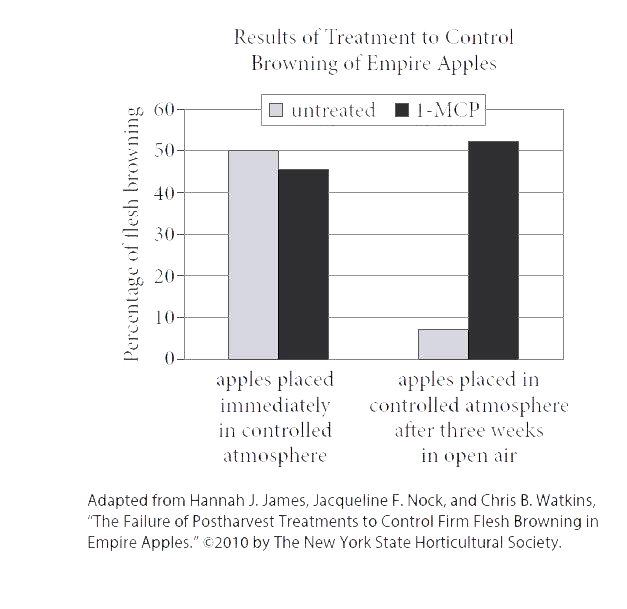 ANO CHANGEBfirmCstiffDtaut
ANO CHANGEBfirmCstiffDtaut
Maria plans to rent a boat. The boat rental costs $60 per hour,and she will also have to pay for a water safety course that costs $10. Maria wants to spend no more than $280 for the rental and the course. If the boat rental is available only for a whole numberof hours,what is the maximum number of hours for which Maria can rent the boat?
View SolutionHow Do You Like Those Apples? Marketed as SmartFresh, the chemical 1-MCP (1-methylcyclopropene) has been used by fruit growers since 2002 in the United States and elsewhere to preserve the crispness and lengthen the storage life of apples and other fruit, which often must travel long distances before being eaten by consumers. 23 1-MCP lengthens storage life by three to four times when applied to apples. This extended life allows producers to sell their apples in the off-season, months after the apples have been harvested. And at a cost of about one cent per pound of apples, 1-MCP is a highly cost-effective treatment. However, 1-MCP is not a panacea for fruit producers or sellers: there are problems and limitations associated with its use.[1] 1-MCP works by limiting a fruit’s production of ethylene, 24 it is a chemical that causes fruit to ripen and eventually rot. [2] While 1-MCP keeps apples 25 tight and crisp for months, it also limits 26 their scent production. [3] This may not be much of a problem with certain kinds of apples that are not naturally very fragrant, such as Granny Smith, but for apples that are prized for their fruity fragrance, such as McIntosh, this can be a problem with consumers, 27 that will reject apples lacking the expected aroma. [4] But some fruits do not respond as well to 1-MCP as others 28 did, and some even respond adversely. [5] Furthermore, some fruits, particularly those that naturally produce a large amount of ethylene, do not respond as well to 1-MCP treatment. [6] Take Bartlett 29 pears, for instance, unless they are treated with exactly the right amount of 1-MCP at exactly the right time, they will remain hard and green until they rot, and consumers who experience this will be unlikely to purchase them again. 30 Finally, researchers have found that 1-MCP actually increases susceptibility to some pathologies in certain apple varieties. For example, Empire apples are prone to a condition that causes the flesh of the apple to turn brown. Traditionally, apple producers have dealt with this problem by leaving the apples in the open air for three weeks before storing them in a controlled atmosphere with tightly regulated temperature, humidity, and carbon dioxide levels. As the graph shows, the flesh of untreated Empire apples that are first stored in the open air undergoes 31 roughly five percent less browning than the flesh of untreated Empire apples that are immediately put into storage in a controlled environment. However, when Empire apples are treated with 1-MCP, 32 their flesh turns brown when the apples are first stored in the open air, though not under other conditions. Although researchers continue to search for the right combination of factors that will keep fruits fresh and attractive, 33 the problem may be that consumers are overly concerned with superficial qualities rather than the actual freshness of the fruit.
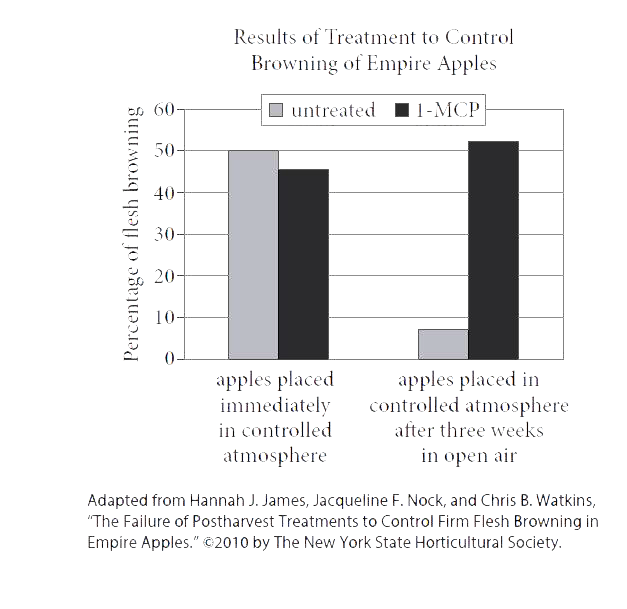
Which choice offers an accurate interpretation of the data in the graph?
View SolutionHow Do You Like Those Apples? Marketed as SmartFresh, the chemical 1-MCP (1-methylcyclopropene) has been used by fruit growers since 2002 in the United States and elsewhere to preserve the crispness and lengthen the storage life of apples and other fruit, which often must travel long distances before being eaten by consumers. 23 1-MCP lengthens storage life by three to four times when applied to apples. This extended life allows producers to sell their apples in the off-season, months after the apples have been harvested. And at a cost of about one cent per pound of apples, 1-MCP is a highly cost-effective treatment. However, 1-MCP is not a panacea for fruit producers or sellers: there are problems and limitations associated with its use.[1] 1-MCP works by limiting a fruit’s production of ethylene, 24 it is a chemical that causes fruit to ripen and eventually rot. [2] While 1-MCP keeps apples 25 tight and crisp for months, it also limits 26 their scent production. [3] This may not be much of a problem with certain kinds of apples that are not naturally very fragrant, such as Granny Smith, but for apples that are prized for their fruity fragrance, such as McIntosh, this can be a problem with consumers, 27 that will reject apples lacking the expected aroma. [4] But some fruits do not respond as well to 1-MCP as others 28 did, and some even respond adversely. [5] Furthermore, some fruits, particularly those that naturally produce a large amount of ethylene, do not respond as well to 1-MCP treatment. [6] Take Bartlett 29 pears, for instance, unless they are treated with exactly the right amount of 1-MCP at exactly the right time, they will remain hard and green until they rot, and consumers who experience this will be unlikely to purchase them again. 30 Finally, researchers have found that 1-MCP actually increases susceptibility to some pathologies in certain apple varieties. For example, Empire apples are prone to a condition that causes the flesh of the apple to turn brown. Traditionally, apple producers have dealt with this problem by leaving the apples in the open air for three weeks before storing them in a controlled atmosphere with tightly regulated temperature, humidity, and carbon dioxide levels. As the graph shows, the flesh of untreated Empire apples that are first stored in the open air undergoes 31 roughly five percent less browning than the flesh of untreated Empire apples that are immediately put into storage in a controlled environment. However, when Empire apples are treated with 1-MCP, 32 their flesh turns brown when the apples are first stored in the open air, though not under other conditions. Although researchers continue to search for the right combination of factors that will keep fruits fresh and attractive, 33 the problem may be that consumers are overly concerned with superficial qualities rather than the actual freshness of the fruit.
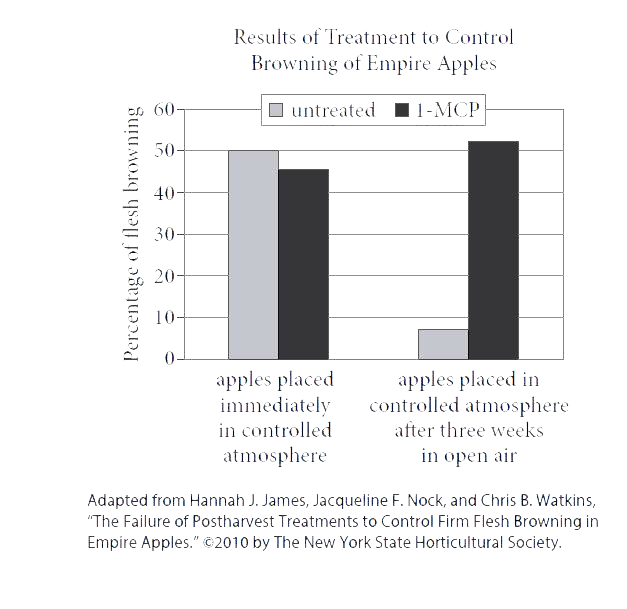
To make this paragraph most logical sentcence 4 should be placed
View SolutionHow Do You Like Those Apples? Marketed as SmartFresh, the chemical 1-MCP (1-methylcyclopropene) has been used by fruit growers since 2002 in the United States and elsewhere to preserve the crispness and lengthen the storage life of apples and other fruit, which often must travel long distances before being eaten by consumers. 23 1-MCP lengthens storage life by three to four times when applied to apples. This extended life allows producers to sell their apples in the off-season, months after the apples have been harvested. And at a cost of about one cent per pound of apples, 1-MCP is a highly cost-effective treatment. However, 1-MCP is not a panacea for fruit producers or sellers: there are problems and limitations associated with its use.[1] 1-MCP works by limiting a fruit’s production of ethylene, 24 it is a chemical that causes fruit to ripen and eventually rot. [2] While 1-MCP keeps apples 25 tight and crisp for months, it also limits 26 their scent production. [3] This may not be much of a problem with certain kinds of apples that are not naturally very fragrant, such as Granny Smith, but for apples that are prized for their fruity fragrance, such as McIntosh, this can be a problem with consumers, 27 that will reject apples lacking the expected aroma. [4] But some fruits do not respond as well to 1-MCP as others 28 did, and some even respond adversely. [5] Furthermore, some fruits, particularly those that naturally produce a large amount of ethylene, do not respond as well to 1-MCP treatment. [6] Take Bartlett 29 pears, for instance, unless they are treated with exactly the right amount of 1-MCP at exactly the right time, they will remain hard and green until they rot, and consumers who experience this will be unlikely to purchase them again. 30 Finally, researchers have found that 1-MCP actually increases susceptibility to some pathologies in certain apple varieties. For example, Empire apples are prone to a condition that causes the flesh of the apple to turn brown. Traditionally, apple producers have dealt with this problem by leaving the apples in the open air for three weeks before storing them in a controlled atmosphere with tightly regulated temperature, humidity, and carbon dioxide levels. As the graph shows, the flesh of untreated Empire apples that are first stored in the open air undergoes 31 roughly five percent less browning than the flesh of untreated Empire apples that are immediately put into storage in a controlled environment. However, when Empire apples are treated with 1-MCP, 32 their flesh turns brown when the apples are first stored in the open air, though not under other conditions. Although researchers continue to search for the right combination of factors that will keep fruits fresh and attractive, 33 the problem may be that consumers are overly concerned with superficial qualities rather than the actual freshness of the fruit.

Which choice offers an accurate interpretation of the data in the graph?
View SolutionHow Do You Like Those Apples? Marketed as SmartFresh, the chemical 1-MCP (1-methylcyclopropene) has been used by fruit growers since 2002 in the United States and elsewhere to preserve the crispness and lengthen the storage life of apples and other fruit, which often must travel long distances before being eaten by consumers. 23 1-MCP lengthens storage life by three to four times when applied to apples. This extended life allows producers to sell their apples in the off-season, months after the apples have been harvested. And at a cost of about one cent per pound of apples, 1-MCP is a highly cost-effective treatment. However, 1-MCP is not a panacea for fruit producers or sellers: there are problems and limitations associated with its use.[1] 1-MCP works by limiting a fruit’s production of ethylene, 24 it is a chemical that causes fruit to ripen and eventually rot. [2] While 1-MCP keeps apples 25 tight and crisp for months, it also limits 26 their scent production. [3] This may not be much of a problem with certain kinds of apples that are not naturally very fragrant, such as Granny Smith, but for apples that are prized for their fruity fragrance, such as McIntosh, this can be a problem with consumers, 27 that will reject apples lacking the expected aroma. [4] But some fruits do not respond as well to 1-MCP as others 28 did, and some even respond adversely. [5] Furthermore, some fruits, particularly those that naturally produce a large amount of ethylene, do not respond as well to 1-MCP treatment. [6] Take Bartlett 29 pears, for instance, unless they are treated with exactly the right amount of 1-MCP at exactly the right time, they will remain hard and green until they rot, and consumers who experience this will be unlikely to purchase them again. 30 Finally, researchers have found that 1-MCP actually increases susceptibility to some pathologies in certain apple varieties. For example, Empire apples are prone to a condition that causes the flesh of the apple to turn brown. Traditionally, apple producers have dealt with this problem by leaving the apples in the open air for three weeks before storing them in a controlled atmosphere with tightly regulated temperature, humidity, and carbon dioxide levels. As the graph shows, the flesh of untreated Empire apples that are first stored in the open air undergoes 31 roughly five percent less browning than the flesh of untreated Empire apples that are immediately put into storage in a controlled environment. However, when Empire apples are treated with 1-MCP, 32 their flesh turns brown when the apples are first stored in the open air, though not under other conditions. Although researchers continue to search for the right combination of factors that will keep fruits fresh and attractive, 33 the problem may be that consumers are overly concerned with superficial qualities rather than the actual freshness of the fruit.
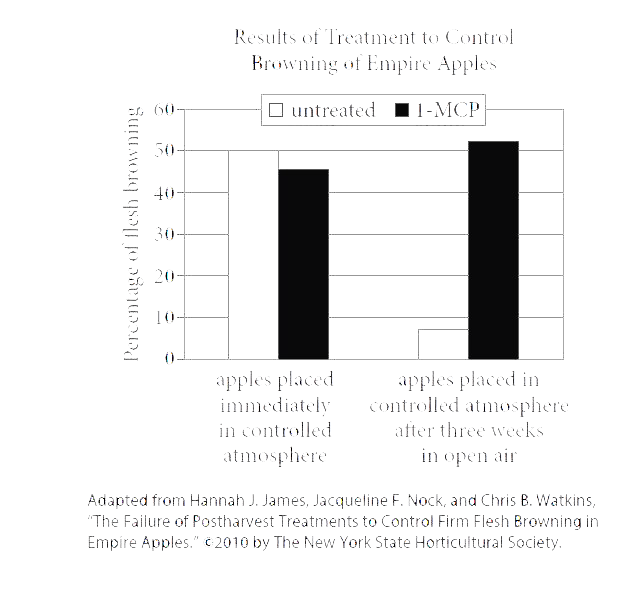
View Solution
